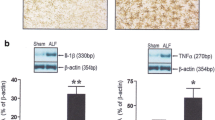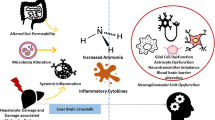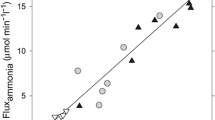Abstract
The concept of synergistic mechanisms as the pathophysiologic basis of hepatic encephalopathy started with the pioneering work of Les Zieve in Minneapolis some 60 years ago where synergistic actions of the liver-derived toxins ammonia, methanethiol, and octanoic acid were described. More recently, synergistic actions of ammonia and manganese, a toxic metal that is normally eliminated via the hepatobiliary route and shown to accumulate in brain in liver failure, on the glutamatergic neurotransmitter system were described. The current upsurge of interest in brain inflammation (neuroinflammation) in relation to the CNS complications of liver failure has added a third dimension to the synergy debate. The combined actions of ammonia, manganese and pro-inflammatory cytokines in brain in liver failure result in oxidative/nitrosative stress resulting from activation of glutamate (NMDA) receptors and consequent nitration of key brain proteins. One such protein, glutamine synthetase, the sole enzyme responsible for brain ammonia removal is nitrated and inactivated in brain in liver failure. Consequently, brain ammonia levels increase disproportionately resulting in alterations of brain excitability, impaired brain energy metabolism, encephalopathy and brain swelling. Experimental therapeutic approaches for which proof-of-principle has been established include the NMDA receptor antagonist memantine, N-acetyl cysteine (recently shown to have antioxidant properties at both hepatic and cerebral levels) and probiotics.



Similar content being viewed by others
References
Ahboucha S, Pomier Layrargues G, Mamer O, Butterworth RF (2005) Increased brain concentrations of a neuroinhibitory steroid in human hepatic encephalopathy. Ann Neurol 58:169–170
Bemeur C, Vaquero J, Desjardins P, Butterworth RF (2010) N-acetyl cysteine attenuates cerebral complications of non-acetaminophen-induced acute liver failure in mice: antioxidant and anti-inflammatory mechanisms. Metab Brain Dis 25:241–249
Bernal W, Hall C, Karvellas CJ, et al. (2007) Arterial ammonia and clinical risk factors for encephalopathy and intracranial hypertension in acute liver failure. Hepatology 4:1844--1852
Blei AT (2004) Infection, inflammation and hepatic encephalopathy: synergism redefined. J Hepatol 40:327–330
Burkhard PR, Delavelle J, Du Pasquier R, Spahr L (2003) Chronic parkinsonism associated with cirrhosis: a distinct subset of acquired hepatocerebral degeneration. Arch Neurol 60:521–528
Butterworth RF (2013) Parkinsonism in cirrhosis: pathogenesis and current therapeutic options. Metab Brain Dis 28:261–267
Butterworth RF, Spahr L, Fontaine S, Layrargues GP (1995) Manganese toxicity, dopaminergic dysfunction and hepatic encephalopathy. Metab Brain Dis 10:259–267
Cagnin A, Taylor-Robinson SD, Forton DM, Banati RB (2006) In vivo imaging of “peripheral benzodiazepine sites” in patients with hepatic encephalopathy. Gut 55:547–553
Challenger F, Walshe JM (1955) Methyl mercaptan in relation to fetor hepaticus. Biochem J 59:372–375
Chastre A, Jiang W, Desjardins P, Butterworth RF (2010) Ammonia and pro-inflammatory cytokines modify expression of genes coding for astrocytic proteins implicated in brain edema in acute liver failure. Metab Brain Dis 25:17–21
Chastre A, Belanger M, Nguyen BN, Butterworth RF (2014) Lipopolysaccharide precipitates hepatic encephalopathy and increases blood-brain barrier permeability in mice with acute liver failure. Liver Int 34(3):353–61
Clemmesen JO, Larsen FS, Kondrup J, et al. (1999) Cerebral herniation in patients with acute liver failure is correlated with arterial ammonia concentrations. Hepatol 29:648–653
Desjardins P, Butterworth RF (2002) The “peripheral-type” benzodiazepine (omega-3) receptor in hyperammonemic disorders. Neurochem Int 41:109--114
Hazell AS, Norenberg MD (1997) Manganese decreases glutamate uptake in cultured astrocytes. Neurochem Res 22:1443–1447
Jiang W, Desjardins P, Butterworth RF (2009a) Direct evidence for central proinflammatory mechanisms in rats with experimental acute liver failure: protective effect of hypothermia. J Cereb Blood Flow Metab 29:944–952
Jiang W, Desjardins P, Butterworth RF (2009b) Hypothermia attenuates oxidative/nitrosative stress, encephalopathy and brain edema in acute (ischemic) liver failure. Neurochem Int 55:124–128
Lai JCK, Cooper AJL (1986) Brain alpha-ketoglutarate dehydrogenase complex: kinetic properties, regional distribution and effects of inhibitors. J Neurochem 47:1376–1386
Lavoie J, Pomier Layrargues G, Butterworth RF (1990) Increased densities of peripheral-type benzodiazepine receptors in brain autopsy samples from cirrhotic patients with hepatic encephalopathy. Hepatol 11:874–878
Lockwood AH, Yap EW, Wong WH (1991) Cerebral ammonia metabolism in patients with severe liver disease and minimal hepatic encephalopathy. J Cereb Blood Flow Metab 11:337–341
McClain CJ, Zieve L, Doizaki WM, et al. (1980) Blood methanethiol in alcoholic liver disease with and without hepatic encephalopathy. Gut 21:318–323
Michalak A, Rose C, Butterworth J, Butterworth RF (1996) Neuroactive amino acids and glutamate (NMDA) receptors in frontal cortex of rats with experimental acute liver failure. Hepatol 24:908–913
Pomier Layrargues G, Spahr L, Butterworth RF (1995) Increased manganese concentrations in pallidum of cirrhotic patients. Lancet 345:735
Rolando N, Wade J, Davalos M, et al. (2000) The systemic inflammatory response syndrome in acute liver failure. Hepatology 32:734--739
Schliess F, Gorg B, Fischer R, et al. (2002) Ammonia induces MK-801-sensitive nitration and phosphorylation of protein tyrosine residues in rat astrocytes. FASEB J:739–741
Spahr L, Butterworth RF, Fontaine S et al. (1996) Increased blood manganese in cirrhotic patients: relationship to pallidal magnetic resonance signal hyperintensity and neurological symptoms, Hepatol 24:1116–1120
Vogels BA, Maas MA, Daalhuisen J, et al. (1997) Memantine, a non-competitive NMDA receptor antagonist improves hyperammonemia-induced encephalopathy and acute liver failure encephalopathy in rats. Hepatol 25:820–827
Zieve L (1989) Role of toxins and synergism in hepatic encephalopathy. In: Butterworth RF, Layrargues GP (eds) Hepatic encephalopathy: pathophysiology and treatment. Humana Press, Clifton, NJ, p 141--156
Zieve L, Doizaki WM, Zieve FJ (1974) Synergism between mercaptans and ammonia or fatty acids in the production of coma: a possible role for mercaptans in the pathogenesis of hepatic coma. J Lab Clin Med 83:16–28
Author information
Authors and Affiliations
Corresponding author
Additional information
This review article was based on the Andy Blei Lecture delivered at the 2014 biennial meeting of the International Society for Hepatic Encephalopathy and Nitrogen Metabolism (ISHEN) in London, UK.
Rights and permissions
About this article
Cite this article
Butterworth, R.F. Pathogenesis of hepatic encephalopathy in cirrhosis: the concept of synergism revisited. Metab Brain Dis 31, 1211–1215 (2016). https://doi.org/10.1007/s11011-015-9746-1
Received:
Accepted:
Published:
Issue Date:
DOI: https://doi.org/10.1007/s11011-015-9746-1




